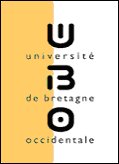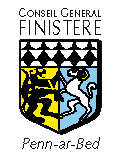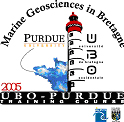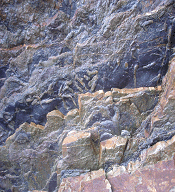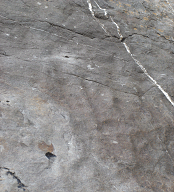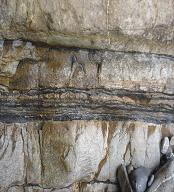|
INTRODUCTION
The studied area, a part of Veryarc'h Beach (illustrated in Figure
1) is composed of ordovician formations. The area is divided into
two parts; the first is the Schists of Postolennec, of middle ordovician
age, and the second formatin is the Sandstones of Kermeur, of upper
ordovician age. Figure 2 illustrates the cross section of the area.
I.
POSTOLENNEC
Lithology and stratigraphy
The shales of Postolennec are composed of detrital terrigenous sediments
and clay. The color of the deposits is dark due to the organic matter
content. In these, we find many fragmented fossils, like trilobites
and crinoids, along with laminations due to tectonics. Between important
shale beds, there are lower layers of broken shells. This thin bed
is composed of many fragmented shells called coquinas storm bed.
Interpretation
After
analyzing the shales, it can be concluded that the clay and terrigenous
sediments are deposited on the continental shelf with a low energy.
However, during high energy events, such as storms, many shells
in life postition are dispersed in many small heaps. After the storm,
the shells are broken and dispersed regularly on this surface. That
explains the thin beds which we see.
II.
KERMEUR
Lithology and stratigraphie
The Sandstones of Kermeur are divided into two parts, the lower
and the middle part. The stratum of the lower Kermeur is heterogenous
and made of alternatively different beds. Here we notice two major
beds. The formation is composed of thin sandstone beds and thicker,
reworked beds and the lithology is not the same. The sandstone layers
are beige and medium- to coarse-grained while the intermediate layers
are grey and fine-grained. These beds contain complete fossils in
life position and therefore have also been affected by bioturbidity.
The tubes made by organisms are perpendicular as well as horizontal
to the deposited beds. Figures 3 and 4 are illustrations of such
bioturbidity.
The
middle Kermeur formation is formed of thick, beige sandstone beds
which are composed of coarse-grained sand. This formation has homogeneous
stratum and is topped with a succession of thin sandstone beds,
which are laminated and of the same lithology. There are also bioturbidity
systems (Figure 5) and ripple marks (Figure 6, 7).
After
analyzing the Kermeur formation, one can make a few conclusions.
For the lower formation, it is evident that the deposition occurred
under a low energy system. We propose the idea that the sediments
were deposited in a lagoon or a zone which was protected by the
marine environment as well as storms. The surface, however, has
been reworked and marked by alterations of beige and grey sediments.
This began the regressive phase.
The
middle Kermeur formation contains sediments which were deposited
during a transgressive phase. The ripple marks and the bioturbidity
support this theory. Also, the sediments are laminated and deposited
toward the coastline due to gravity and the sediment density.
III.
THE BOUNDARY
The boundary between these two formations is rather sharp. On the
Postolonnec side of the boundary, there are a few laminated layers
of pebbles in a matrix. After extracting some samples and running
tests, local universities have agreed that the pebbles are eroded
pieces of the older Postolonnec formation that were later redeposited
in the younger matrix near the Postolonnec/Kermeur boundary. Also,
there are tiny fragments of silica throughout the laminated layers
approaching the boundary. On the Kermeur side of the boundary, the
sandstone layers appear instantly.
Analyzing the boundary, one may wonder if the pebbles in matrix
are a local event. After some research, it is evident that this
late Postolonnec erosion is not a local event, but has been seen
in many other countries, such as Portugal and Morocco. This indicates
that there was a large-scale regression. The observations made of
the Kermeur formation indicate a transgression, which has also been
seen in many countries.
CONCLUSION
The older Postolonnec formation of Veryarc'h Beach is composed of
dark shale and coquinas storm beds and was the continental shelf
during its deposition. At the boundary of the Postolonnec and the
Kermeur formations, a large-scale regression, and therefore erosion,
occurred. The lower Kermeur formation is composed of alternating
sandstones and a mix of clay and sandstone. This is due to the depositional
environment, the lagoon. And lastly, the middle Kermeur formation
is composed of thin, laminated sandstones, due to the transgression.
|
